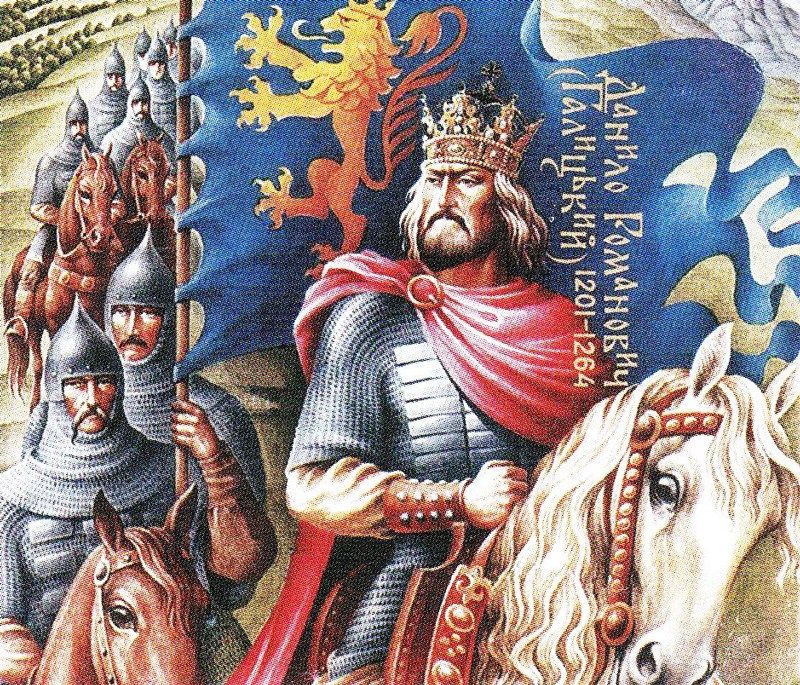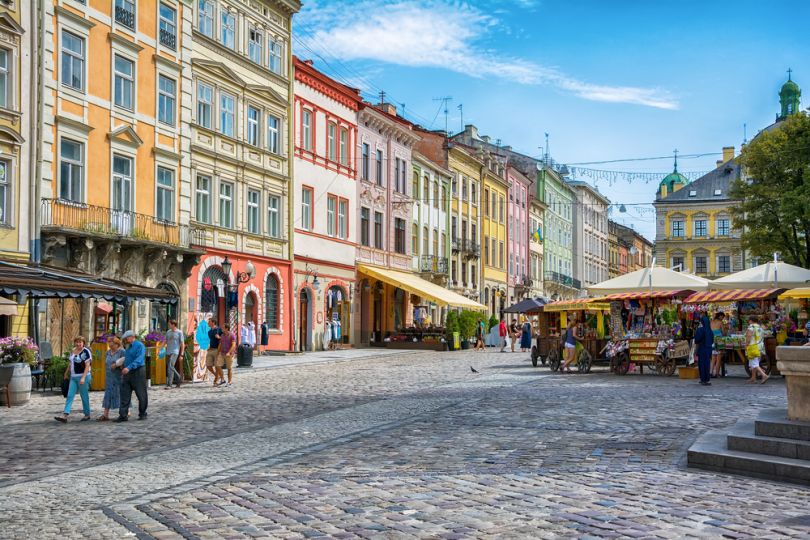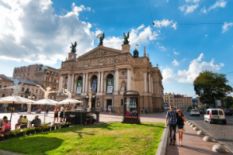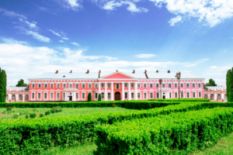The Foundation of Lviv
 Image: Danylo Halytskyi, the King of Rus, Prince of Galicia
Image: Danylo Halytskyi, the King of Rus, Prince of Galicia
When it comes to the first days of Lviv, many people love referring to legends. One of them is specifically connected to the symbol of the city. It says that the lion that lived in the woods near Lviv gave the oath to protect not only the forest he ruled in but also the city dwellers he kept peace with. One day, he defended the princess Constance from evil charms of the Black Knight and was hit by a poisoned arrow. When the lion was dying, he swore to keep to his oath of protecting the city even in the afterlife. After the arrow was taken out of his body, amazed citizens saw a statue of a lion right in front of them. The sculpture of a lion sitting on its hind legs and holding the front shield with the emblem of the city became the symbol of Lviv and it remains to this day.
However, history tells another story regarding the city's name. According to historical estimates, Lviv was founded in the middle of the 13th century by Prince Danylo Halitskyi, who named the city after his son Lev. The first written mentioning of Lviv dates back to 1256 in the Galicia-Volhynian chronicle. According to the description, at the time Lviv consisted of the Dytyntsi (High Castle), the royal residence (Low Castle) and the fortified suburbs in the area of the modern Staryi Rynok Square. The chronicle also mentions a huge fire that occurred in Chełm. The fire was so great that it was visible even from other settlements, namely from Lviv. Soon began the city's extensive and rich history, making Lviv unique and giving it its very special vibe that can be felt even nowadays.
Lviv in the Kingdom of Galicia–Volhynia
 Image: Modern-day Rynok Square, originally founded by Casimir III
Image: Modern-day Rynok Square, originally founded by Casimir III
During the late 13th century, Lviv quickly developed which resulted in becoming the capital of Galicia-Volhynia principality in 1272. For decades, Romanovych dynasty has reigned over the region, taken over by Dmytro Dedko in 1340-49. However, 1349 was the changing point, a start of the new era in the city's history. Polish king Casimir III the Great seized the city, astonished by its beauty and location. In 1356 he granted Lviv the Magdeburg Law. The fact opened many opportunities for development and independent life of the city. Under the Casimir III reign, the city structure had several changes - downtown was moved from the Old Market Square to a new city in the south, around Rynok Square.
The majority of the population was German colonists, while non-Catholics deprived of the rights of the Lviv bourgeoisie lived in the outskirts (modern-day Armenian, Russian, Staroevreyskaya Streets). During the next centuries, Lviv became a multinational and multi-religious city which had an immense influence on culture, science and commerce of the whole Galicia–Volhynia. Moreover, thanks to the fortifications built by Casimir III, Lviv became one of the most important points that protected the Commonwealth from the south-east.
Polish-Lithuanian Commonwealth Period
Lviv was located on an important section of the Great Silk Road, which explained its commercial boom and expansion. During the Polish-Lithuanian Commonwealth period, Lviv acquires the Saxon style in architecture. Several Gothic churches, like the Church of the Holy Spirit, the Dominican Monastery, the Church of the Holy Cross with the Franciscan Monastery, the wall of the southeast Church of Andrew with the Bernardine Monastery were erected during that period. Unfortunately, the Saxon Lviv is lost to contemporary tourists. 1527 marked the largest fire in the history of Lviv, which ruined the city completely. Even though most of the surviving citizens wanted to leave, the burgomaster decided to rebuild Lviv and gave it a second life.The second half of the 16th century marks a great cultural Renaissance of Lviv. Thus, Ivan Fedorov came to the city in 1572 to organize a private printing house in Podzamci. The next year, Ukraine saw its first printed books, Apostol and Bukvar. In fact, at the beginning of the 17th century, Lviv surpassed Kyiv both in size and in terms of population by two times. The population reached 25-30 thousand people. The reason behind is that Lviv at the time was the largest trade and craftsmanship center on the territory of modern Ukraine. Craftsmen were united in more than 33 workshops that were located in different parts of the city.
This period in architecture is remarkable with stone constructions: houses on the Rynok Square, the new Assumption Church on Ruska Street and the Golden Rose, which was unfortunately destroyed by the Soviet and Nazi Armies during the WWII. The second half of the 17th century marks the start of the slow decline of Lviv and the whole Polish-Lithuanian Commonwealth. Multiple internal conflicts and wars exhausted the city. Finally, in 1704 Lviv was conquered by Charles XII of Sweden.
Under the Reign of Austria-Hungarian Empire
In 1772, Lviv is given to the jurisdiction of the Austrian Empire as a result of the redistribution of the Polish state. Starting this year and until 1918, the city is officially called Lemberg. The Austrian reign over the city lasted for the next 150 years. Lviv has lost a number of churches and monasteries as a result of the church reform of Emperor Joseph II. However, the expansion continued with classicism being the main architecture style of the period. In 1783 Lviv University was restored as a secular institution, consisting of 4 faculties. At the time, the German language was official in all institutions, which was true for universities as well. The new Town Hall was built in 1826 after its eventual collapse.The seemingly quiet period was interrupted by the Spring of Nations in 1848. Democratic revolutions that swept through Europe reached Lviv as well - in May, an oppressed ethnic group called Rusyns organized the Main Rusyn Council in Lviv. It mainly consisted of priests, who stated political aspirations of the Galician Rusyns. The notable achievement of the 1848 revolution is the publishing of the first Ukrainian newspaper 'Zorya Halytska'. The demonstrations were soon suppressed by the Austrian authorities.
However, the progress couldn't be stopped. In 1861, Lviv gets its own transportation system. The first in Ukraine railway system was laid from Krakow, connecting Lviv and Vienna. In 1894, an electric tram was implemented in Lviv, earlier than in neighboring Vienna and Krakow. The city was bustling with life, producing more and more scientific inventions.
Two World Wars
The first half of the 20th century wasn't kind to the city of Lions. The city was captured by Russian troops in September 1914. Russian Tsar Nicholas II proclaimed the reunification of Galicia with Russia, which led to liquidating numerous national political, cultural and educational organizations and publishing houses. The cultural elite of Lviv was massively deported to Siberia. In 1915 the Austrian troops returned to Galicia. Lviv returned to Austria-Hungary, but not for long.On November 1, 1918, Lviv was proclaimed the capital of the Western Ukrainian People's Republic (ZUNR). Ukrainian authorities announced a general mobilization to form a Ukrainian Galician Army that withstood Polish troops. Parisian accords concluded that Lviv would stay under the reign of Poland until further redistribution. The Golden Age of Austrian Lviv was quickly changed to a practical, survivalist pace of the post-WWI. New suburbs were built to give accommodation to the growing population - before the WWII, Lviv was home to more than 300 people compared to 210 in 1910. This was soon to change when the World War II sparked in Europe.
According to the Molotov-Ribbentrop Plan, all Halicia including Lviv was joined to the USSR. On September 12, 1939, the Wehrmacht began the siege of the city. Almost a week later, the Red Army approached the city and on September 22 the Polish command transferred Lviv to the Soviet Union. Nazi Germany opposed the 1941 proclamation of an independent Ukraine under Shukhevych, and on July 12, Hitler ordered to arrest the entire Ukrainian government. Gestapo then arrested the leader of the Ukrainian nationalists Stepan Bandera, who refused to withdraw the Independence Act. On July 24, Soviet troops took Lviv in a ring, and in two days the city was captured by the Red Army. The local leadership of the Army Krajova was arrested by the NKVD. Lviv became a part of the Ukrainian Soviet Socialist Republic.
Post-WWII and Nowadays
 Image: Lviv in 1980s
Image: Lviv in 1980s
Like in the most parts of Ukraine, the Soviet government pursued a brutal suppressing of the Ukrainian nationalist movement. The main focus was made on destroying religious organizations, like Ukrainian Greek Catholic Church, whose parishes were forcibly translated into the Russian Orthodox Church. Abandoning its religious background, Lviv became a large manufacturer of the Ukrainian Soviet Socialist Republic. By the beginning of the 1980s, 137 large enterprises in Lviv manufactured buses, televisions, software-controlled machines and many other devices that were exported to the whole USSR.
In 1991, after the fall of the Soviet Union, Lviv reinvents itself and keeps to an independent patriotic spirit it is known for nowadays. In 1998, the historic city center called the Old Town and St. George's Cathedral were listed as a UNESCO World Heritage Site. Lviv has sparked a touristic boom in Ukraine, attracting foreigners with the unique vibe, a mix of different architectural styles, multicultural heritage and delicious coffee. In 2010, Lviv celebrated 770 years since its foundation — let's hope it stays for at least as many more.
Sources: spadok.org.ua, ukraine-in.ua.
Photo sources: photo-lviv.in.ua, discoverukraine.com, Tainar, Ruslan Lytvyn / Shutterstock.com. All images belong to their rightful authors. All images belong to their rightful authors.
















